|

by Christopher Joyce
August 20,
2018
from
NPR Website
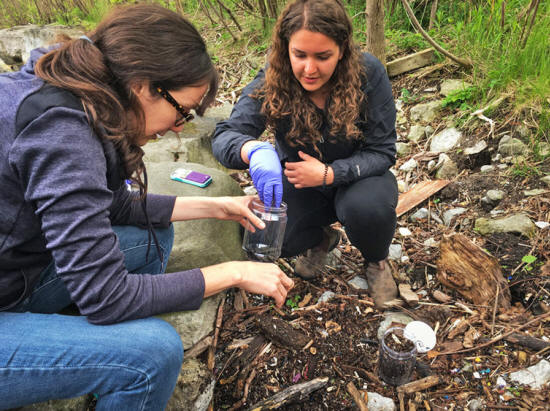
Ecologist Chelsea Rochman (left)
and
researcher Kennedy Bucci
dig
through washed-up debris along Lake Ontario.
They're
looking for small particles of plastic
that
make their way into oceans, rivers and lakes.
Chris Joyce/NPR
Plastic trash is littering the land and fouling rivers and oceans.
But what we can see is only a small fraction of what's out there.
Since modern plastic was first mass-produced,
8 billion tons have been
manufactured. And when it's thrown away, it doesn't just disappear.
Much of it crumbles into small pieces.
Scientists call the tiny pieces "microplastics"
and define them as objects smaller than 5 millimeters - about the
size of one of the letters on a computer keyboard. Researchers
started to pay serious attention to microplastics in the environment
about 15 years ago.
They're in oceans, rivers
and lakes. They're also in soil...
Recent research in
Germany found that fertilizer made from composted household waste
contains microplastics.
And, even more concerning, microplastics are,
How microplastics get
into animals is something of a mystery, and
Chelsea Rochman is trying to
solve it.
Rochman is an ecologist at the University of Toronto. She studies
how plastic works its way into the food chain, from tiny plankton to
fish larvae to fish, including fish we eat.
She says understanding how plastic gets into fish matters not just
to the fish, but to us.
"We eat fish that eat
plastic," she says.
"Are there things
that transfer to the tissue? Does the plastic itself transfer to
the tissue? Do the chemicals associated with the plastic
transfer to the tissue?"
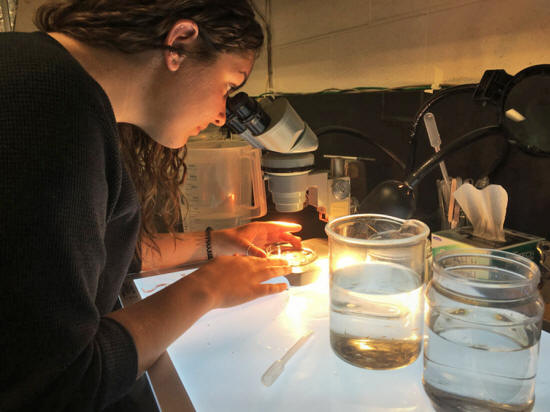
Bucci uses a microscope
to look
at a fathead minnow larva
that
has ingested plastic particles.
Chris Joyce/NPR
Rochman says she has always loved cleaning up. She remembers how, as
a 6-year-old, she puzzled her parents by volunteering to clean the
house.
In high school in Arizona
she got even more ambitious.
"I used to take my
friends into the desert and clean up a mile of trash every Earth
Day," she says. "I remember finding weird old dolls and strange
old toys that I thought were creepy, but that I would also
keep."
As a graduate student,
she landed a spot on a research vessel to visit the
infamous floating garbage patch in the Pacific
Ocean.
She and the other
scientists on the trip were supposed to count the plastic as it
drifted by.
She remembers the moment they sailed into the patch,
"Everyone runs up to
the bow and says, 'There's trash, there's trash, everyone start
counting the trash.' And so we all start counting the trash."
But something was wrong.
"We're looking and
it's, like, basically a soup of confetti, of tiny little plastic
bits everywhere," she remembers.
"Everyone just stops
counting. [They] sat there, their backs up against the wall and
said, 'OK, this is a real issue, [and it's] not an island of
trash you can pick up."
To Rochman, a third thing
was also clear:
"The tiny stuff, for
me as an ecologist, this is really getting into the
food chain. You could spend a career studying this
stuff."
So she did...
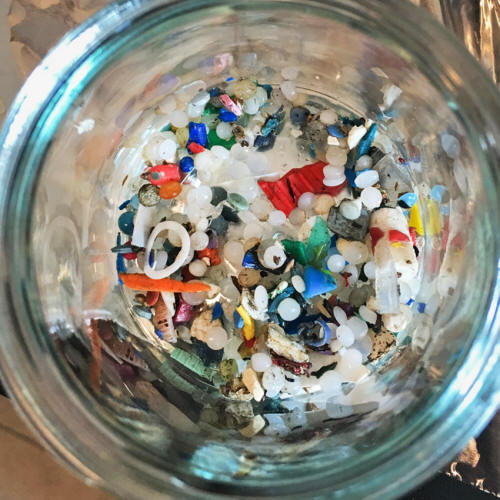
Microplastics found
along
Lake Ontario by Rochman's team
Chris Joyce/NPR
A world of
plastic
A typical day for Rochman might start alongside sparkling Lake
Ontario, where parks line the shore and joggers and picnickers enjoy
the shoreline scenery.
The lake, however, hides
a mostly invisible menace.
To see it, Rochman's student, Kennedy Bucci, brings us to an
inlet that's ankle-deep in washed-up debris. An apartment building
looms overhead.
They squat down, reach
into the muck and quickly find what they're looking for.
"I'm digging and just
finding more and more," Rochman says. "Like whole bottle caps.
This is insane."
"It's so ingrained in the soil," says Bucci.
She comes here regularly
to collect plastic for Rochman's research.
They work quickly,
filling a jar with bits of plastic.
Rochman, who's not
wearing gloves, inadvertently picks up something she wishes she
hadn't.
"Oh!" she laughs,
flinging it aside. "That's why you've got gloves on," she tells
Bucci, and then gets right back to digging.
Since she started
studying microplastics, Rochman has found them in the outflow
from sewage treatment plants...
And they've shown up in
insects, worms, clams, fish and birds.
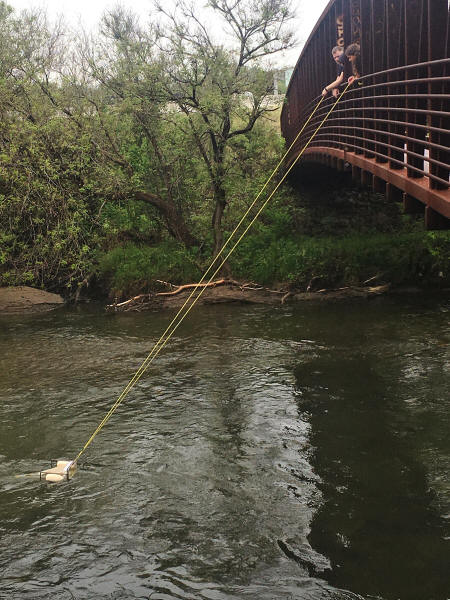
Rochman's scientific team
drops a
net into a stream in Toronto
to
collect tiny floating pieces of plastic.
Chris Joyce/NPR
To study how that happens, Bucci makes her own microplastics from
the morning's collection.
She takes a postage
stamp-size piece of black plastic from the jar, and grinds it into
particles using a coffee grinder.
"So this is the
plastic that I feed to the fish," she says.
The plastic particles go
into beakers of water containing fish larvae from fathead minnows,
the test-animals of choice in marine toxicology.
Tanks full of them line
the walls of the lab. Bucci uses a pipette to draw out a bunch of
larvae that have already been exposed to these ground-up plastic
particles. The larva's gut is translucent.
We can see right into it.
"You can see kind of
a line of black, weirdly shaped black things," she points out.
"Those are the microplastics."
The larva has ingested
them...
Rochman says microplastic particles can sicken or even kill larvae
and fish in their experiments.
Plastic can also get into fish tissue, particularly plastic fibers
from clothing such as fleece. Rochman found fleece fibers in fish
from San Francisco Bay.
She also looked in fish
from Indonesia, a tropical country whose residents are not known for
dressing in fleece. She found plastic
in Indonesian fish guts, but no
fibers, suggesting that fish bodies tell a story about what kind of
plastic resides in local waters.
Rochman took this line of research a step further when she bought a
washing machine for her lab and washed fleece clothing. Lots of
plastic fibers came out in the filter she added to collect the
wastewater.
In fact, she has found
microplastics floating in the air...
"If you put a piece
of double-sided sticky tape on a lab bench for an hour, you come
back and it's got four plastic fibers on it," she says.
Resilient, durable
and potentially dangerous
Most plastic is inert; it does not readily react chemically with
other substances, and that's one reason it has been so successful.
Plastic is resilient,
durable and doesn't easily degrade. It's a vital part of medical
equipment and has revolutionized packaging, especially food storage.
But, over time, plastic can break down and shed the chemicals that
make it useful, such as
phthalates and
bisphenol A.
These substances are
common in the environment and their effects on human health are of
concern to public health scientists and advocates, but few
large-scale, definitive studies have been done.
Plastic also
attracts other chemicals in the
water that latch onto it, including toxic industrial compounds like
polychlorinated biphenyls, or
PCBs.
Plastic becomes a
chemical Trojan horse...
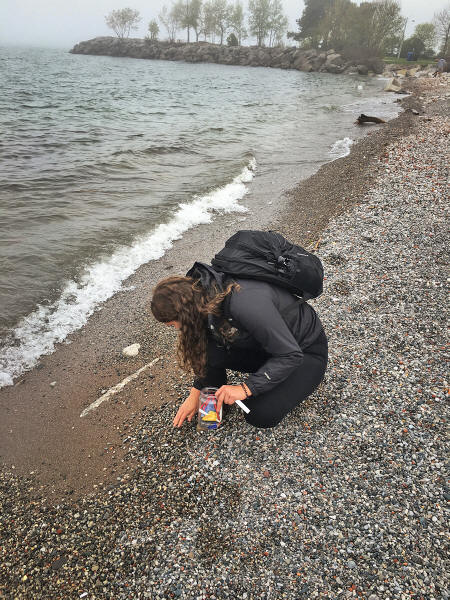
Researcher Kennedy Bucci
collects plastics from the shore
of Lake
Ontario in Toronto.
Chris Joyce/NPR
Tracking all those chemicals is researcher Clara Thaysen's
job.
"Right now we're
starting with the common types of plastic, so polyethylene,
polypropylene [and] polystyrene," she explains.
"But, there's..." she pauses and sighs. "There's tons."
Plastic comes in many
forms, with a wide variety of chemical additives depending on how
the plastic is used.
What happens to plastic
over decades just hasn't been studied deeply.
"This happens all the
time," says Thaysen. "We invent something that seems really
great and... we don't think and we become so dependent on it."
Rochman notes that this
kind of research is relatively new; most of the environmental
studies on microplastics have come out within the past 10 years.
"The things we don't
know," she says, "are daunting."
"What are all the
sources where it's coming from, so that we can think about where
to turn it off? And once it gets in the ocean, where does it go?
Which is
super-important because then we can understand how it impacts
wildlife and humans."
She says she's ready to
spend the rest of her career finding out...
| 





